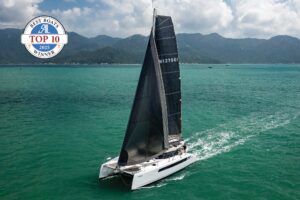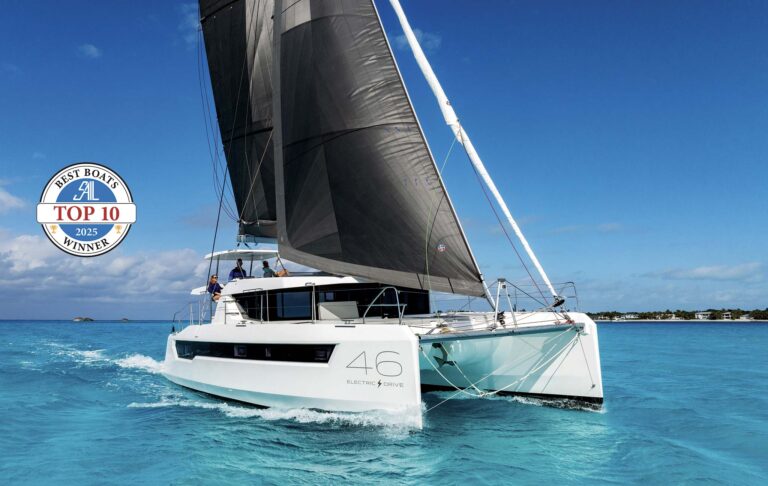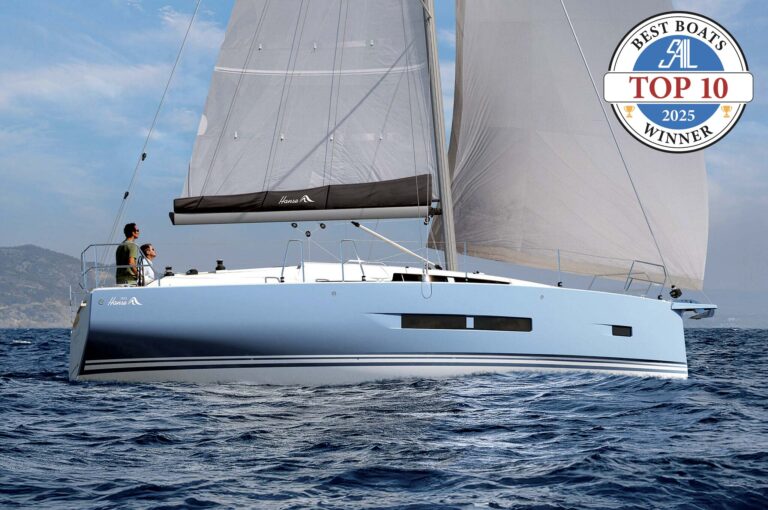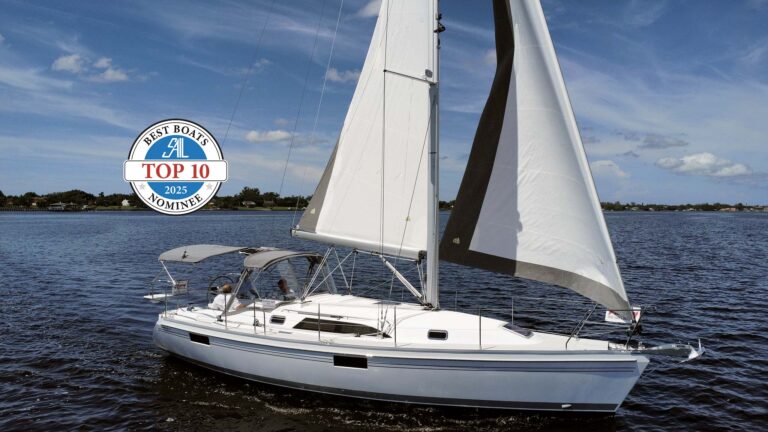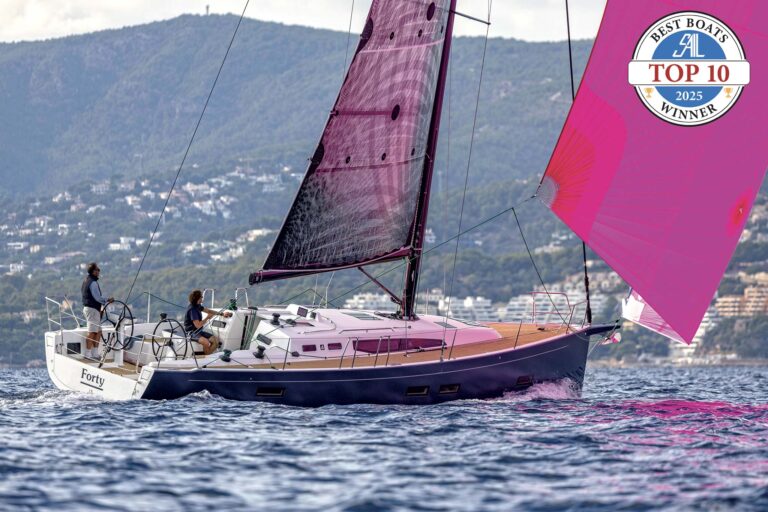
It’s fitting that one of the most interesting big cruisers I’ve sailed in a long while came out of a small Florida yard that builds trailerable sailboats. No mass-production builder could have come up with the Seaward 46RK—it wouldn’t have got past the focus groups. This innovative variable-draft cruiser is the boat designer/builder Nick Hake has always wanted to own, and he’s certain he’s not the only one.
Construction
Like the smaller Seawards, the 46 is built of fiberglass mat and rovings, laid up by hand. The hull is cored with Divinycell foam above the waterline. A vinylester skin coat and NPG gelcoat provide blister resistance. There is little core in the deck, which is stiffened by the headliner molding. This is a complex boat: there are over 40 moldings of various sizes. The heart of the structure is an extremely strong curved composite bulkhead, which carries rig and keel loads. The keel fin retracts completely, and the beavertail lead ballast bulb tucks into a recess in the hull. The boat can dry out on this bulb, with skegs to protect the propeller(s). A conservative double-spreader masthead rig provides the motive power.
On Deck
The long, low house has full-length grabrails leading up to the foredeck, where you’ll find a wide, deep locker big enough to swallow fenders and a cruising chute. The single anchor roller is on a molded sprit to keep the hook and rode away from the plumb bow. With no sheet tracks to worry about, the side decks are enviably clear. Molded bulwarks are topped by an aluminum toerail. The hefty molding at the base of the mast contains an electric motor that lifts the keel and the top of the keel trunk itself. The gooseneck is affixed to this molding, so the boom and mainsail can be left in place when the mast is removed. This ties into future plans for a cantilevered mast that will allow the boat to slip under low bridges.
Control lines lead to Harken winches on the cabintop and cockpit coamings. Each has a molded-in rope bin. The mainsheet traveler is mounted atop a stainless steel arch, an excellent safety feature that de-clutters the cockpit and lets the helmsman tend to the sheet.
The cockpit seats are wide with flip-up extensions to make them long enough to sleep on, and the coamings are deep enough to provide decent back support. The boat’s comparatively narrow beam obviates the need for twin helms; there’s plenty of room to wander around behind the wheel, with comfortable perches on either side. Helm seating options include a swiveling captain’s chair.
Cockpit stowage is divided between shallow trays under the seats and bigger lockers in the quarters. A pair of bins on the boarding platform are big enough to hold fenders and docklines.
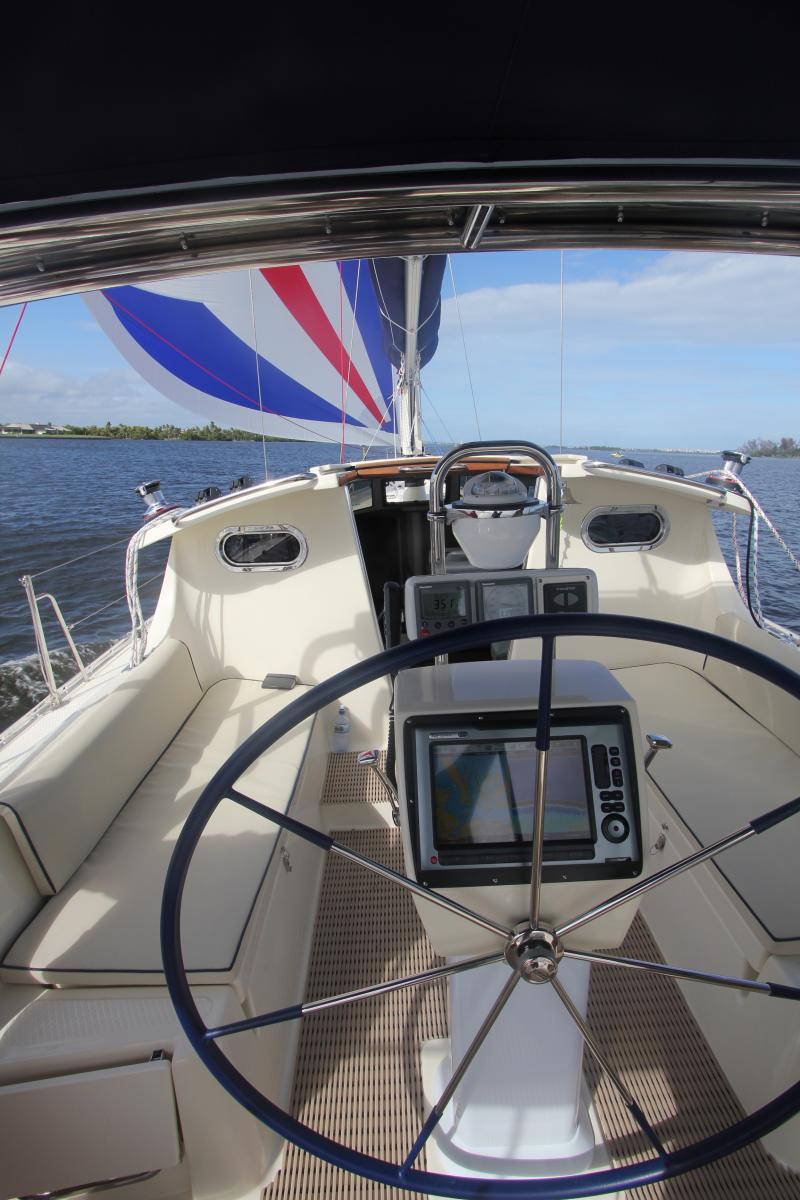
Accommodations
Despite the hull’s relatively narrow beam, there is plenty of room belowdecks. Nick Hake has spent a lot of time pondering what works best for the kind of sailing he likes to do, and the results are interesting.
First you descend two steps onto a raised platform, on which is set a large swiveling captain’s chair. From here, you have an almost-panoramic view out the deckhouse portlights and can steer via autopilot. Before you is a small desk just big enough for an open cruising guide with a Raymarine chartplotter set above it. Tankage is below this platform, along with space for a generator.
Tucked under the side deck to port is a small workstation with a built-in desktop computer. It too has a rather overlarge captain’s chair—Nick is looking into smaller alternatives for the next boat.
A linear galley runs along the port side. It has decent stowage and oodles of worktop space—which, oddly, lacks fiddles—and a gratifyingly large sink. Underneath, there is a fridge, freezer and icemaker. Opposite, the C-shaped dinette is slightly constrained by the keelbox. It will be comfortable for four, cozy for six. The table (also lacking fiddles) drops to form a double berth.
The owner’s cabin is forward, where ventilation is better and headroom isn’t affected by inconvenient cockpit moldings. It is large, airy and well lit. Space has been used differently here too, with the handbasin and vanity separate from the toilet/shower compartment. Stowage is generous and thoughtfully arranged.
The aft head is rather bold—its “roof” is opaque acrylic and intrudes into the main cabin. As in the forward cabin, the toilet and shower share one compartment, and the handbasin is set in the short walkway to the starboard aft cabin. Both aft cabins are reasonably airy, with stowage in lockers and soft bags.
The fiberglass moldings are nicely offset by generous teak trim and paneling. The test boat was loaded with extras: systems are well installed and easily accessible.
Under Sail
We headed out onto the Intracoastal Waterway in a 10- to 12-knot breeze with a reef in the big mainsail to cope with forecast 18-knot gusts. Low-friction luff cars made easy work of sweating up the main, and the self-tacking jib, set on an electric Seldén furler, unrolled at the press of a button. The third sail, a Code 0, was set on an endless-line furler controlled from the cockpit.
A strong current made our tacking angles and speed-over-ground readings either optimistic or pessimistic, but with that long waterline and slim hull the boat is no slouch, as indicated by its D/L and SA/D ratios. It powered up nicely out of tacks and tracked beautifully, steering hands-off at apparent wind angles as high as 35 degrees; hardly surprising, given the twin rudders and hefty twin skegs. We spent some time fiddling with the keel and rudder draft, noting (not surprisingly) that the boat made more leeway with the keel half-retracted. When we ran aground briefly, a flick of the switch lifted the keel enough for us to sail nonchalantly off the sandbank.
A brief foray into open water revealed no vices in the sizeable and confused swell that was running. In such conditions, a slim hull is always more comfortable than a beamy one.

Under Power
Our test boat was equipped with twin 54hp Yanmar diesels, which slot neatly into a well insulated box beneath the companionway. A single 75hp diesel is standard. The twin engines provide both extra punch and redundancy, a point we appreciated when battery problems sidelined one diesel and we got back to the slip with the “spare.” With the twin 54s, the boat cruises at 8.5 knots at 2,200 rpm.
Conclusion
Though it’s certainly capable of offshore cruising, the 46RK’s natural environment is the shallow waters of the East Coast, Florida Keys and Bahamas. With a minimum draft of well under three feet, it will out-gunkhole most cruising catamarans and open up cruising grounds that are otherwise out of reach. Its very quirkiness is a big part of its appeal.
Specifications
HEADROOM 6ft 3in minimum
BERTHS 6ft 10in x 5ft 3in (fwd); 7ft x 5ft 3in (aft)
LOA 48ft // LWL 44ft 10in // BEAM 13ft 3in
DRAFT 2ft 5in (min), 7ft 6in (max)
DISPLACEMENT 23,000lb
BALLAST 7,500lb
SAIL AREA 1,006ft2 (100% FT)
FUEL/WATER/WASTE (GAL) 140/180/60
ENGINE 75hp Yanmar diesel (std), 2 x 54hp (optional)
ELECTRICAL 4 x 110AH (house), 1 x 85AH (engine)
DESIGNER Nick Hake
BUILDERHake Yachts LLC, 772-287-3200


